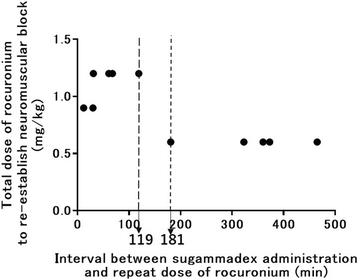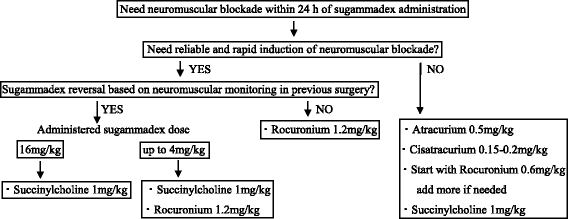Preparing for the unexpected: special considerations and complications after sugammadex administration
- PMID: 29041919
- PMCID: PMC5645926
- DOI: 10.1186/s12871-017-0429-9
Preparing for the unexpected: special considerations and complications after sugammadex administration
Abstract
Sugammadex, a modified gamma-cyclodextrin, has changed clinical practice of neuromuscular reversal dramatically. With the introduction of this selective relaxant binding agent, rapid and reliable neuromuscular reversal from any depth of block became possible. Sugammadex can reverse neuromuscular blockade without the muscarinic side effects typically associated with the administration of acetylcholinesterase inhibitors. However, what remained unchanged is the incidence of residual neuromuscular blockade. It is known that sugammadex cannot always prevent its occurrence, if appropriate dosing is not chosen based on the level of neuromuscular paralysis prior to administration determined by objective neuromuscular monitoring. Alternatively, excessive doses of sugammadex administered in an attempt to ensure full and sustained reversal may affect the effectiveness of rocuronium in case of immediate reoperation or reintubation. In such emergent scenarios that require onset of rapid and reliable neuromuscular blockade, the summary of product characteristics (package insert) recommends using benzylisoquinolinium neuromuscular blocking agents or a depolarizing agent. However, if rapid intubation is required, succinylcholine has a significant number of side effects, and benzylisoquinolinium agents may not have the rapid onset required. Therefore, prior administration of sugammadex introduces a new set of potential problems that require new solutions. This novel reversal agent thus presents new challenges and anesthesiologists must familiarize themselves with specific issues with its use (e.g., bleeding risk, hypermagnesemia, hypothermia). This review will address sugammadex administration in such special clinical situations.
Keywords: Anticholinesterase; Neostigmine; Neuromuscular block; Neuromuscular blocking drugs; Neuromuscular function; Pharmacologic reversal; Sugammadex.
Conflict of interest statement
Ethics approval and consent to participate
Not applicable.
Consent for publication
Not applicable.
Competing interests
Dr. Brull has had investigator-initiated funded research from Merck, Inc., Kenilworth, New Jersey (all funds directed to Mayo Clinic), is a member of the Board of Directors for Anesthesia Patient Safety Foundation (APSF, Rochester, MN), a shareholder and member of the Board of Directors in Senzime AB (publ) (Uppsala, Sweden), and is a member of the Scientific Advisory Board for ClearLine MD (Woburn, MA) and The Doctors Company (Napa, CA). Dr. Renew has had investigator-initiated funded research from Merck, Inc., Kenilworth, New Jersey (all funds directed to Mayo Clinic). Dr. Iwasaki and Dr. Kunisawa declare no competing interests.
Publisher’s Note
Springer Nature remains neutral with regard to jurisdictional claims in published maps and institutional affiliations.
Figures


Similar articles
-
A novel approach to reversal of neuromuscular blockade.Minerva Anestesiol. 2009 May;75(5):349-51. Minerva Anestesiol. 2009. PMID: 19412157 Review.
-
Sugammadex: a cyclodextrin to reverse neuromuscular blockade in anaesthesia.Expert Opin Pharmacother. 2008 Jun;9(8):1375-86. doi: 10.1517/14656566.9.8.1375. Expert Opin Pharmacother. 2008. PMID: 18473711 Review.
-
Reversal with sugammadex in the absence of monitoring did not preclude residual neuromuscular block.Anesth Analg. 2013 Aug;117(2):345-51. doi: 10.1213/ANE.0b013e3182999672. Epub 2013 Jun 11. Anesth Analg. 2013. PMID: 23757472
-
Do we really need sugammadex as an antagonist of muscle relaxants in anesthesia?Curr Opin Anaesthesiol. 2016 Aug;29(4):462-7. doi: 10.1097/ACO.0000000000000359. Curr Opin Anaesthesiol. 2016. PMID: 27168088 Review.
-
Low-Dose or High-Dose Rocuronium Reversed with Neostigmine or Sugammadex for Cesarean Delivery Anesthesia: A Randomized Controlled Noninferiority Trial of Time to Tracheal Intubation and Extubation.Anesth Analg. 2016 May;122(5):1536-45. doi: 10.1213/ANE.0000000000001197. Anesth Analg. 2016. PMID: 26974018 Clinical Trial.
Cited by
-
Utilization Patterns of Perioperative Neuromuscular Blockade Reversal in the United States: A Retrospective Observational Study From the Multicenter Perioperative Outcomes Group.Anesth Analg. 2020 Nov;131(5):1510-1519. doi: 10.1213/ANE.0000000000005080. Anesth Analg. 2020. PMID: 33079874 Free PMC article.
-
Use of intraoperative neuromuscular monitor reduces the reversal dose of sugammadex: a single-center retrospective study.J Anesth. 2020 Apr;34(2):276-280. doi: 10.1007/s00540-020-02739-1. Epub 2020 Jan 28. J Anesth. 2020. PMID: 31993747
-
Cardiac Arrest in the Post-anesthesia Care Unit (PACU): Postoperative Recurrence of Neuromuscular Block After Sugammadex Reversal.Cureus. 2024 Jan 21;16(1):e52681. doi: 10.7759/cureus.52681. eCollection 2024 Jan. Cureus. 2024. PMID: 38380199 Free PMC article.
-
Does Deep Neuromuscular Blockade Improve Operating Conditions during Minimally Invasive Anterolateral Total Hip Replacements?: A Randomized Controlled Trial.Cureus. 2020 Sep 9;12(9):e10328. doi: 10.7759/cureus.10328. Cureus. 2020. PMID: 33052289 Free PMC article.
-
Potential Adverse Effects of Sugammadex Administration: A Scoping Review.Cureus. 2025 Jan 19;17(1):e77666. doi: 10.7759/cureus.77666. eCollection 2025 Jan. Cureus. 2025. PMID: 39968427 Free PMC article. Review.
References
-
- Khuenl-Brady KS, Wattwil M, Vanacker BF, Lora-Tamayo JI, Rietbergen H, Alvarez-Gomez JA. Sugammadex provides faster reversal of vecuronium-induced neuromuscular blockade compared with neostigmine: a multicenter, randomized, controlled trial. Anesth Analg. 2010;110:64–73. doi: 10.1213/ane.0b013e3181ac53c3. - DOI - PubMed
-
- Abad-Gurumeta A, Ripolles-Melchor J, Casans-Frances R, Espinosa A, Martinez-Hurtado E, Fernandez-Perez C, Ramirez JM, Lopez-Timoneda F, Calvo-Vecino JM. A systematic review of sugammadex vs neostigmine for reversal of neuromuscular blockade. Anaesthesia. 2015;70:1441–1452. doi: 10.1111/anae.13277. - DOI - PubMed
Publication types
MeSH terms
Substances
LinkOut - more resources
Full Text Sources
Other Literature Sources

